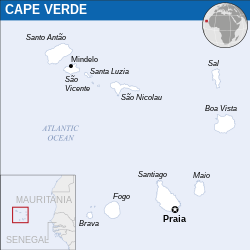
| Part of a series on the |
| Culture of Cape Verde |
|---|
 |
| History |
| People |
| Languages |
| Cuisine |
| Religion |
| Literature |
Music and performing arts |
Media |
| Sport |
Monuments |
The history of the Jews in Cape Verde deals with the Jews and Jewish communities in Cape Verde.

| Part of a series on |
| Jews and Judaism |
|---|
| Part of a series on the |
| Culture of Cape Verde |
|---|
 |
| History |
| People |
| Languages |
| Cuisine |
| Religion |
| Literature |
| Sport |
The history of the Jews in Cape Verde deals with the Jews and Jewish communities in Cape Verde.
Historians agree that the Jewish population of Cape Verde has its roots in the upheavals of the Spanish and Portuguese Inquisitions with the persecutions of Spanish and Portuguese Jews who were often forced to either submit to apostasy or had to flee from their homelands, or both. [1] A second influx of Jews arrived in Cape Verde in the nineteenth and twentieth centuries from Morocco and Gibraltar. [2]
During the early colonial era, Portuguese Cape Verde had a population of so-called lançados (meaning "thrown-out ones") consisting of exiled Crypto-Jews and New Christians.
Jews were allowed to engage in trade craftsmanship as long as they did not compete with the Portuguese trading monopolies. [1]
An American-based organization “Cape Verde Jewish Heritage Project” [3] has been set up to restore the Jewish cemeteries and create an archive about Jewish ancestry of Cape Verde, and according to its president Carol Castiel its "goal is to honor the memory and explore the contributions of the many Sephardic Jewish families who immigrated to Cape Verde from Morocco and Gibraltar in the mid-19th century." [3] This project was the subject of articles in The Forward : Honoring Cape Verde’s Jewish History (2009); [4] the Washington Jewish Week : Preserving a Jewish niche Group seeks to honor the ghosts of Cape Verde(2009); [5] and reported in the Jewish Telegraphic Agency: Cape Verdean municipalities advance Jewish preservation (2010) [6] about agreements to maintain Jewish cemeteries on Ribeira Grande (Santo Antao), Praia and Boa Vista, as well as meetings with notables for this cause such as at the Cape Verdean American Business Association in 2010. [7]
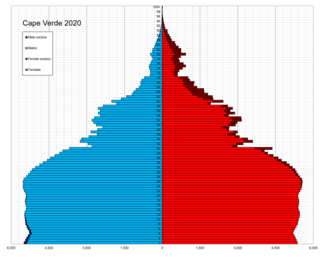
This article is about the demographic features of the population of Cape Verde, including population density, ethnicity, education level, health of the populace, economic status, religious affiliations and other aspects of the population.

The Cape Verde national football team represents Cape Verde in men's international association football and is controlled by the Cape Verdean Football Federation. The team has never qualified for FIFA World Cups but has qualified for three Africa Cup of Nations tournaments, in 2013, 2015 and 2021.

Carlos Alberto Wahnon de Carvalho Veiga is a Cape Verdean politician. He was Prime Minister of Cape Verde from April 4, 1991 to July 29, 2000.
Cape Verdean Americans are an ethnic group of Americans whose ancestors were Cape Verdean. In 2010, the American Community Survey stated that there were 95,003 Americans living in the US with Cape Verdean ancestors.

Jews of the Bilad al-Sudan describes West African Jewish communities which were connected to known Jewish communities which were expelled from the Middle East, North Africa, or Spain and Portugal and migrated to West Africa. Various historical records state that at one time, they were present in the Ghana, Mali, and Songhai empires, which was then called the Bilad as-Sudan a name which is derived from the Arabic term which means Land of the Blacks. In later years Jews who were expelled from Spain, Portugal, and Morocco and migrated to West Africa, also formed their own communities off the coast of Senegal as well as on the Islands of Cape Verde. These Jewish communities continued to exist for hundreds of years but they eventually disappeared as a result of changing social conditions, persecution, migration, and assimilation.

Cesária ÉvoraGCIH, more commonly known as Cize, was a Cape Verdean singer-songwriter. She received a Grammy Award in 2004 for her album Voz d'Amor. Nicknamed the "Barefoot Diva" for performing without shoes, she was known as the "Queen of Morna".
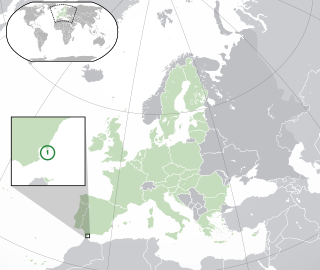
The history of the Jews in Gibraltar dates back more than 650 years. There have been periods of persecution, but for the most part the Jews of Gibraltar have prospered and been one of the largest religious minorities in the city, where they have made contributions to the culture, defence, and Government of Gibraltar.
Cape Verdean Argentines are Argentine residents whose ancestry originated in Cape Verde. According to the 1980 census, there were about 8,000; but today's population was estimated by some sources to be around 2,000 in 2007. Other sources estimate that in 2006 there were 12,000-15,000 descendants of immigrants from Cape Verde living in Argentina, of whom about 300 are native to the African continent.
Cape Verdeans in France are residents of France who are from Cape Verde or have Cape Verdean ancestry.
Cape Verdeans in the Netherlands consist of migrants from Cape Verde to the Netherlands and their descendants. As of 2010, figures from Statistics Netherlands showed 20,961 people of Cape Verdean origin in the Netherlands.
There were estimated to be 25,000 Cape Verdeans in Senegal as of 1995.
The presence of Cape Verdeans in Italy dates back to the 1960s.

Cape Verde or Cabo Verde, officially the Republic of Cabo Verde, is an archipelago and island country in the central Atlantic Ocean, consisting of ten volcanic islands with a combined land area of about 4,033 square kilometres (1,557 sq mi). These islands lie between 600 to 850 kilometres west of Cap-Vert situated at the westernmost point of continental Africa. The Cape Verde islands form part of the Macaronesia ecoregion, along with the Azores, the Canary Islands, Madeira, and the Savage Isles.

Cape Verde was a colony of the Portuguese Empire from the initial settlement of the Cape Verde Islands in 1462 until the independence of Cape Verde in 1975.
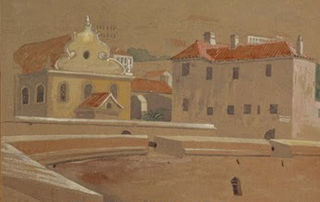
The four active synagogues of Gibraltar are colloquially known as the Great Synagogue, the Little Synagogue, the Flemish Synagogue, and the Abudarham Synagogue. The first synagogue established after the 1717 expulsion of Jews from Gibraltar, the Great Synagogue, was built on what is now known as Engineer Lane, and remains Gibraltar's principal synagogue. The Little Synagogue, founded in 1759 in Irish Town, was the result of the desire of Moroccan Jews for a less formal service. The lavish Flemish Synagogue was built at the turn of the nineteenth century on Line Wall Road, due to the request of some congregants for a return to more formal, Dutch customs. The last synagogue to be established in what is now the British overseas territory of Gibraltar, the Abudarham Synagogue, was founded in 1820 on Parliament Lane by recent Moroccan immigrants.
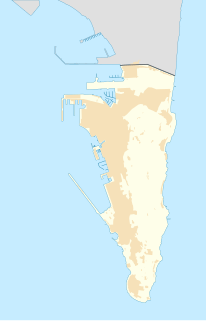
Jews' Gate Cemetery is a Jewish cemetery located on Windmill Hill within a nature reserve in the British Overseas Territory of Gibraltar. Also known as the Windmill Hill Cemetery, it is the site of the earliest known Jewish burials in Gibraltar. The cemetery opened by 1746 and closed in 1848. It is the burial site of a number of Gibraltar's Chief Rabbis. The graveyard is protected by the law of Gibraltar.
Solomon Abudarham was Chief Rabbi of the British Overseas Territory of Gibraltar until his death from yellow fever in December 1804. Also known as Shelomo Abudarham II, the rabbi established a school of religious study on Parliament Lane and laid the inaugural stone for the Flemish Synagogue on Line Wall Road. In 1820, his academy was converted into the Abudarham Synagogue, named after the rabbi.
Cape Verdeans, also called Cabo Verdeans, are the citizens of Cape Verde, an island nation consisting of an archipelago in the central Atlantic Ocean. Cape Verde is a sociedade mestiça, which means that it is home to mixed-race people, whose ethnogenesis is in Cape Verde, which has no indigenous population.

The history of the Jews in Madeira spans the entire length of the history of Madeira itself. The history of Madeira begins with the discovery of the islands by Portugal in 1419. Madeira is presently officially the Autonomous Region of Madeira, and is one of the two autonomous regions of Portugal. It is an archipelago situated in the north Atlantic Ocean, southwest of Portugal. Its total population was estimated in 2016 at 289,000. The capital of Madeira is Funchal, which is located on the main island's south coast.

Carmen Souza is a Portuguese jazz singer and songwriter of Cape Verdean heritage. She combines traditional forms of Cape Verde with contemporary and traditional jazz.